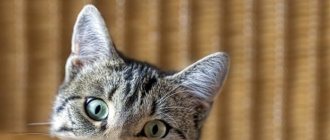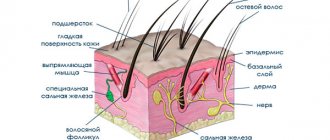If a cat's lower jaw is swollen, this may be a sign of traumatic injury, inflammation of the gums and lips, or neoplasm. The condition is accompanied by drooling, pain, and loss of appetite due to pain. At the first symptoms, you should take your pet to a veterinarian, who will determine the cause of the swelling and prescribe treatment.
According to veterinary oncologist A. Shimshirt, tumors of the lower jaw and oral cavity are more often diagnosed in older cats, which by the age of 10-12 years have chronic diseases.
Diseases of the teeth and oral cavity
If a cat's lower jaw is swollen, the likely cause is oral disease. In older cats we are talking about dental diseases. With age, teeth begin to loosen, lose hardness, and begin to crumble. Any microcracks in the enamel lead to the development of a pathological process, which results in complete decay of the tooth. In cats, the roots of the teeth are located deep in the gum tissue, so tooth decay can lead to the formation of a seal on the lower jaw. Associated symptoms:
- refusal to eat;
- jaw turned to one side;
- lethargy and weakness;
- no pain when pressed.
Typically, animals experiencing dental problems refuse to eat. At the same time, the cat experiences severe hunger and can in every possible way attract attention to its own bowl, but as soon as it is filled, the pet will turn away and leave. This is because chewing food causes pain.
The structure of the tumor will tell you about the possible causes. If a hard neoplasm is noticeable upon palpation, but the cat breaks out and does not allow itself to be touched, a cyst of the lower jaw is a possible cause. This neoplasm can be caused by dental diseases and is an overgrowth of bone tissue in the lower jaw.
If a soft and heterogeneous structure is noted upon palpation, the possible cause is an abscess, the development of which is due to the presence of pathogenic microorganisms in the oral cavity. This happens when pathogenic agents penetrate deeply into the root of the tooth. The abscess must be opened surgically, but there are cases when it breaks out on its own.
We recommend the article: Anatomy and physiology of a cat: main characteristics
Diseases of the oral cavity and teeth in cats are indicated by foul breath, red gums and impaired jaw movement during eating. This pathology can only be treated surgically - it is necessary to remove rotten teeth, open an abscess or cyst. If the abscess has opened on its own, antiseptic treatment should be carried out several times a day to avoid secondary infection of the wound cavity. During surgical removal, the doctor must prescribe antibiotics to prevent infection of healthy oral tissues.
What are the causes of swelling?
Traumatic injuries
Cats love to rub their faces against various objects, leaving their marks on them. Therefore, your pet may accidentally get hurt or get a splinter. A foreign body provokes inflammation, which causes swelling. A pet can hit its face during outdoor games and a hematoma occurs, in which bleeding occurs under the skin. Symptoms:
- painful swelling;
- unexpressed asymmetry of the muzzle;
- bloody crust if the skin is damaged;
- purulent discharge when the inflammatory process was not detected in a timely manner and the wound became infected.
Gum inflammation
Gingivitis is accompanied by reddening of the gums and bad breath from the pet.
Gingivitis covers the teeth and mucous membranes, spreading to the ligaments and bone structures of the jaw. The main reasons for the development of the disease are a lack of vitamins A and C, the introduction of bones into the diet that injure the gums, the formation of tartar, severe viral diseases, and malocclusion when the teeth regularly damage the mucous membranes. Signs:
- profuse drooling;
- putrid odor from the mouth;
- redness and swelling;
- decreased appetite;
- loss of body weight.
Eosinophilic granuloma
Most often it occurs on the lips due to allergies of various etiologies. It appears as an ulcerative tumor or plaque and appears predominantly on one side of the muzzle. Unfavorable factors for the development of granuloma are helminthic infestation, skin parasites, food components, household chemicals, some types of indoor plants, fungus or mold in the room. Manifestation:
- the appearance of dense nodules and ulcers on the lip;
- swelling;
- absence of pain;
- decreased food and water intake, which causes the cat to lose weight and show signs of dehydration.
Odontogenic osteomyelitis
If the cat refuses to eat and looks lethargic, this indicates the development of the disease.
The causative agent is Staphylococcus aureus. Inflammation affects all bone structures and bone marrow of the lower jaw. The main factor in the development of osteomyelitis is considered to be advanced gingivitis, abscess, periodontal disease, wounds through which infection entered, and incorrectly performed dental procedures. In advanced cases, the cat will not live long. Symptoms:
- local and general hyperthermia;
- lethargy, refusal to play and eat;
- increased thirst;
- the appearance of a fistula on the jaw, from which pus is released;
- heart rhythm disturbance;
- enlargement of local lymph nodes;
- redness, swelling;
- the appearance of areas of necrosis.
Neoplasms
According to veterinarian statistics, tumors of the mandibular joint and oral structures in cats account for 10% of the total number of pathological formations.
A dangerous manifestation in an animal is a salivary gland cyst, as it can degenerate into oncology.
If your cat has a lump on his chin, it could be a benign or malignant tumor. Among non-oncological pathological formations, a cyst of the salivary glands - mucocele - is most often diagnosed. Due to injuries, a cavity is formed in which saliva accumulates. It is manifested by slight swelling, there is no pain. Mucocele is dangerous due to degeneration into cancer.
Among malignant neoplasms, the lower jaw is affected by sarcoma or squamous cell carcinoma, which are characterized by an aggressive course and rapid formation of metastases. Oncology occurs due to a failure of the cell cycle, when cells begin to rapidly divide and form a compaction. Most often, cancer is provoked by the owner’s smoking in the presence of a cat, decreased immunity, and chronic inflammation of the jaw bone. Cats with cancer live 3-12 months. A malignant tumor of the lower jaw manifests itself as follows:
- pronounced compaction that increases in size;
- salivation;
- the appearance of blood clots;
- sudden weight loss;
- strong pain;
- general deterioration of health.
Malignant and benign neoplasms
Malignant tumors in the mouth of animals are rare. However, if the jaw of a cat over 13 years of age is swollen, cancer can only be ruled out after a comprehensive examination of the animal.
There are usually no specific symptoms for jaw cancer. The animal may become lethargic and refuse to eat, but these same signs accompany an abscess and dental problems. To make an accurate diagnosis, it is necessary to take an X-ray of the jaw and take a blood test to identify the inflammatory process. If the presence of a tumor is confirmed, an operation is performed to remove it, followed by tissue examination. For malignant neoplasms, animals are prescribed a course of chemotherapy.
The danger of malignant neoplasms is that they are rarely accompanied by significant symptoms. A jaw tumor at the beginning of development manifests itself in the same way as dental problems, but can cost the cat his life.
With osteosarcoma and squamous cell carcinoma of the jaw, pain is pronounced. The animal cannot chew, drink water, and does not allow the affected area to be touched. In some cases, syringe feeding may be necessary. It is important not to try to treat your pet on your own, but to visit a doctor in a timely manner.
Diagnostics
If a cat has a swollen lower jaw, the veterinarian conducts a visual examination and, depending on the preliminary diagnosis, prescribes the following diagnostic procedures:
Diagnosis involves a number of procedures, including magnetic resonance imaging.
- radiography;
- CT or MRI;
- general and biochemical blood tests;
- biopsy;
- cytological examination.
The cat's jaw is swollen photo
How is the treatment carried out?
The treatment regimen is prescribed by a veterinarian; self-medication of the pet is prohibited. The doctor removes foreign bodies from the skin of the jaw by treating the wound with an antiseptic. If a cat has a swollen chin due to inflammation, antibiotics are used, which are prescribed individually, as well as drainage of the purulent cavity, novocaine blockade. For gingivitis, the oral cavity is treated with drugs such as Miramestin, Chlorhexidine, Dentadin, and Zubastik. Inflammation is relieved with herbal decoctions of chamomile, oregano, and strawberry leaves. If the mouth is swollen due to cancer, surgery is prescribed to remove the tumor. Surgery is required for osteomyelitis, when dead areas of bone and tissue are removed.
Adamantinoma
It is a neoplasm of epithelial tissue, such as enamel, that has not differentiated to the extent that enamel can form. It develops either at the gingival margin (peripheral ameloblastoma, manifested by epulis) or from within the bone (central ameloblastoma). Some of the central ameloblastomas appear as cystic lesions within the bone. Although biologically this tumor is benign and does not metastasize, locally it is extremely infiltrative and aggressive, causing extensive bone resorption, tooth displacement and even resorption of tooth roots.
Odontoma
It is a benign neoplasm of mixed origin, in which both epithelial and mesenchymal cells are fully differentiated. Typically, enamel and dentin in this case are distributed in a pathological manner. Odontoma is usually detected in young animals, and it can develop in any part of the dental arch. Complex odontoma is a disorganized amorphous volumetric formation of hard dental tissues that has no resemblance to normal dental tissue. Mixed complex odontoma consists of several small tooth-like structures. Both types of tumor are encapsulated and often associated with an unerupted tooth. They are benign in nature, but can cause tooth decay and sometimes spread very actively.
The cat's chin is swollen
Hello!
There can be many reasons for the symptoms you describe. Describe in detail the animal's diet, indicating the ingredients included in it. When did you perform routine deworming? When was the animal vaccinated and with what vaccine? What additional vitamin supplements do you use? This is very important diagnostic information. Please provide it as soon as possible.
Please note that feeding Whiskas, Friskas, Meow, Felix and Kitiket food is not recommended for feeding cats. Neither dry nor wet. These are very harmful foods that can sooner or later provoke gastrointestinal diseases and quite often lead to the death of the animal. Sausages, milk, soups, borscht and all other “things that we eat ourselves” are not suitable for feeding cats. This rule is. Feed the animal either high-quality commercial food: Acana, Gina, Orijen, Hills, Royal Canin, Eukanuba, Go Natural, Grandorf or Now Fresh. Or natural products: rice, oatmeal, buckwheat + beef, turkey, rabbit (not in the form of minced meat) and stewed vegetables (cabbage, cauliflower, broccoli, zucchini, carrots, beets). The percentage of meat to the main diet is at least 70%, vegetables 20-25%, cereals 3-5%. Also remember that you should never mix natural food and industrial feed. Vitamins must be used for any type of diet, for 1-1.5 months. 2 r. in year.
Based on the above, it is clear that as a result of chronically long-term malnutrition, the cat developed Eosinophilic granuloma. Perhaps the development of granuloma is associated with recent childbirth and hormonal changes. It is necessary to start treatment.
- Use Royal Canin Hypoallergenic DR25 as nutrition on an ongoing basis for up to 4 months.
- To cauterize the granuloma, use a solution of Methylene blue 3 r. in the village - up to 2-3 months.
- Before cauterizing the granuloma with alcohol, treat with Malavit solution 2-3 r. in the village until 21 days.
As for general treatment, the use of anti-inflammatory drugs (prednisolone, dexamethasone) is recommended. Dosage 0.2-0.3 ml i.m. or p.c. 2 r. in day - up to 14 days or more, then gradually reduce the dose over 5-7 days. up to 0.1 ml 1 r. every 2 days for 10 days, then cancel and continue only local therapy. Immunosuppressive therapy (cyclosporine A) is prescribed if treatment with steroid drugs does not produce a positive effect. The entire treatment process must be constantly monitored by a veterinary doctor.
Simultaneously with hormonal drugs, it is advisable to use Immunofan or Ribotan in a dose of 0.3-0.5 ml i.m. 1 rub. at 2 days, as well as hepatoprotectors Reamberin, Glutorgin, Essentiale.
Health to your pets!
Best regards, Vetpraktika team
Periostitis of the jaw - symptoms and treatment
Treatment of periostitis is always surgical; if you deviate from this rule, there is a serious danger of a limited focus of inflammation flowing into a more dangerous - diffuse form, which will require different treatment tactics and often hospitalization of the patient.
Treatment of periostitis is standard and consists of eliminating the source of primary inflammation and evacuation of pus, i.e., removing the causative tooth (in cases of unfavorable treatment prognosis) and surgically opening the site to its entire width, followed by drainage.
The procedure is usually performed under local anesthesia; in some cases, drug sedation is indicated; anesthesia is also possible. You need to understand that the introduction of an anesthetic into tissues strained by exudate (fluid accumulation) is an extremely painful procedure, therefore, the method of pain relief before periostotomy (opening an abscess) has its own specifics: conduction anesthesia is preferable (a type of anesthesia when the nerve is blocked to the operation site) followed by local anesthesia performed superficially with a thin needle, without immersing the needle into the abscess.
The diseased tooth must be removed in the case of an unfavorable therapeutic prognosis: the presence of large foci of bone destruction, incorrect previously carried out treatment of the canals, resulting in their perforation or blockage by a fragment of an instrument, etc. In cases of a favorable prognosis, endodontic treatment is carried out, which involves the removal of pulp decay from the canals, appropriate mechanical and medicinal treatment of the canals with a special instrument and powerful antiseptics to eliminate infection in them, followed by temporary filling with calcium preparations and temporary filling of the tooth. Subsequent X-ray monitoring is very important in order to confirm the effect of the canal therapy: the focus of destruction in the bone should decrease and subsequently disappear.
To evacuate pus, periostotomy is performed (dissection of the mucosa and periosteum) along the entire length of the infiltrate along the transitional fold.
As a rule, the surgeon detects a characteristic symptom - detachment of the periosteum from the bone, whereas in a healthy state the periosteum is firmly attached to the cortex. At this stage, the abscess is emptied, or the absence of pus is detected along with the periosteal reaction. The surgeon uses a blunt instrument to probe the entire abscess cavity to identify isolated lesions. In the case of the presence of pus, irrigation (washing) of the subperiosteal space with antiseptics is usually carried out, followed by the introduction of drainage (usually a strip of glove rubber) into the wound to prevent its edges from sticking together. The wound is not sutured; the patient is given a dressing after a day or two to remove the drainage [8].
In the absence of contraindications, antibacterial therapy (in most cases, semisynthetic penicillins) and NSAIDs (nonsteroidal anti-inflammatory drugs) are prescribed. In case of severe edema, desensitizing drugs are prescribed. It is also necessary to prescribe analgesics or their direct intramuscular administration after surgery, since in the first hours after treatment, when the effect of the anesthetic wears off, severe pain symptoms appear. It also makes sense to locally cool the infiltrated area with ice for several hours to reduce bleeding and swelling. The cooling time must be assigned based on the patient’s subjective feelings, and not on specific time periods.
Almost always, this treatment leads to a positive result: within a few hours the patient experiences relief, decreased pain and swelling. Although the infiltrate in the form of a moderately painful compaction will persist for several days.
A follow-up visit the next day is necessary to confirm the results of the treatment and possible removal of the drain if there is no discharge from the wound. Subsequently, the patient is observed by a doctor for 3-5 days; it is quite legal to issue a certificate of incapacity for work for this period. After the pronounced symptoms of inflammation disappear, they begin to continue treatment of the causative tooth.
In rare cases, for example, when the incision is of insufficient length or when the drainage falls out and the edges of the wound stick together, treatment may be complicated due to a delay in the evacuation of residual pus from the lesion. In these cases, the incision should be widened and drainage should be ensured by introducing drainage.
Lump on cat's neck due to thyroid gland
Finally, another explanation for why our cat has a lump on her neck could be an increase in the size of the thyroid gland, which is located in the neck and in some cases can be felt. This increase in volume usually occurs due to a benign tumor and consequently leads to excess secretion of thyroid hormones, which cause hyperthyroidism, which affects the entire body.
An affected cat will exhibit symptoms such as hyperactivity, increased hunger and thirst, but thinning, vomiting, poor hair coat, and other rather nonspecific symptoms. It can be detected with a hormonal test and treated with medications, surgery, or radioactive iodine.
The cat has a bump on his face
Finally, once we've identified the most common reasons why a cat has a lump on its neck, we'll see why lumps can appear on their face as well. The cancer, squamous cell carcinoma, can cause nodular lesions, as well as the less common disease cryptococcosis.
Both require veterinary treatment. Cryptococcosis with antifungal drugs, as it is a disease caused by a fungus, and carcinoma can be operated on. As we can see, it is very important to contact a veterinarian as soon as possible in order to begin treatment as early as possible to avoid complications.
Oncological formations
Oral cancer is a rare occurrence. According to statistics, in three cats out of a hundred, cancer causes the formation of a malignant lump in the area where the whiskers grow. Therefore, if you notice a tumor on the face, immediately contact a veterinary clinic.
The cause of a malignant tumor can be a pet’s poor diet, based only on canned food. Smoking by the owner in the presence of the animal. Most often, squamous cell carcinoma or fibrosarcoma . Cancer treatment is carried out outside the home. The sooner the owner contacts the clinic for a diagnosis, the greater the animal’s chances of survival. As a rule, surgical removal of a tumor on the cheek is prescribed. To prevent metastases from appearing, doctors administer chemotherapy. But if the owner missed time, did not pay attention to the symptoms and started the disease, it will not be possible to cure the cancerous tumor.











